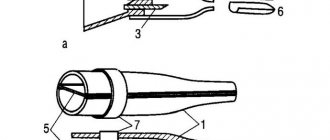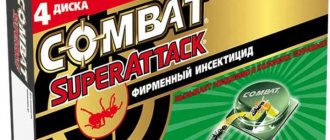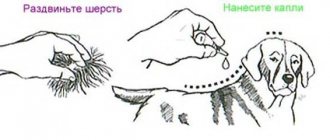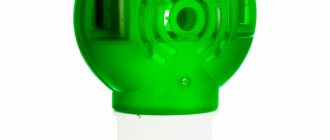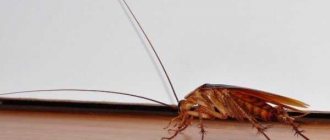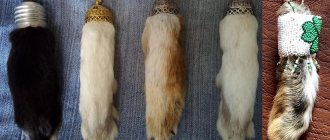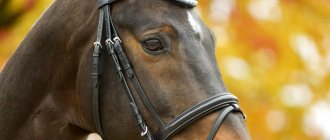Among the many types of dog equipment, a halter often goes unnoticed. It is modestly packaged in a box and it is difficult for an ignorant person to understand its straps. “What is it and why is it needed?” - the buyer is perplexed and, leaving the halter on the shelf, goes further, in search of another strict collar, with brand new shiny links. Meanwhile, a halter is the most effective and safe device of all that is customary to put on a dog’s neck.
A properly sized halter is safe enough for the dog. She can't pull it hard enough to hurt herself. The owner does not need to use jerks - the dog does not pull on the leash if it is wearing a halter.
This is the structure of the dog: it easily “fits” into a collar or harness like a sled husky and pulls the owner, but it can only resist the pressure on the head of the halter by turning its whole body towards the owner and backing away. This explains why a dog in a halter should not be tied and generally left unattended. A halter is designed for walking with a dog on a leash, not tying it up.
How does a halter work?
The device consists of belts (leather or textile) attached to each other according to a certain pattern.
The nose strap is made of a loop, connected to the neck strap by two cheek straps. Metal or plastic rings connect the ends of the nose strap and attach to the leash. All belts must fit tightly to the dog’s skin and not squeeze it. If the device is loosely tightened, the pet will become irritated and inattentive to commands.
The tension of all belts of the device is adjustable. Automatic tension occurs when the dog begins to pull. The pressure exerted by the straps as they tighten causes the animal to stop pulling on the leash.
It is extremely important for your pet to choose a safe, suitable halter.
Then, even in the case of strong tension, he will not be able to harm the dog.
The halter is not suitable for constant use while walking.
A halter is an excellent device for teaching a dog the commands to stand, near, ew.
Its use is a last resort when the dog does not listen to commands and vomits while walking forward, while being transported on public transport and going to the veterinarian. If the animal is aggressive and attacks passers-by, the device cannot replace a muzzle. Since the mouth in this device opens freely, it can bite.
Halter for dogs
When walking, while playing and communicating with other animals, when removing the animal from the leash, you must also remove it.
The device is an excellent assistant in training your pet to follow commands - don’t pull close, in this device the dog understands perfectly what they want from him.
During walking, the device helps control the position of the pet’s head and makes it possible to take the dog’s gaze away from unwanted objects.
A good quality one should be light and durable.
Description and purpose of the accessory
A halter, or halti, will be an addition to a dog collar. It is not difficult to use, and there are many benefits: with the help of such a device you can wean your dog from pulling on the leash and prevent it from going out for a full walk. Thanks to him, the dog better perceives the commands “Near!” and “Don’t delay!” The halter is harmless to the dog, does not put pressure on the neck, and the animal will feel comfortable.
Dog lovers purchase this device because it makes it easier to focus the pet’s attention. If while walking he barks and lunges at cats and other dogs, pull the halter towards you and the dog will turn his head to the side and switch to the distraction
Do the same when the dog sees a treat on the ground. Then she won't be able to reach it to eat it. With the help of such an accessory it is much easier to walk a large dog. This way you can quickly teach your large pet to follow commands.
A dog halter is a useful device that is best used not on daily walks, but on special occasions. For example, if you want to take your pet to the veterinarian, but he is stubborn. Even when you go to a store or take public transport, wear this accessory. When you are going to let your dog out to play with other pets, remove the halter: you don’t need any unnecessary injuries to the animal. You cannot leave your dog unattended when walking around with this accessory, otherwise it will get caught on something.
Some novice dog owners confuse a halter with a muzzle. These are two completely different subjects. A dog wearing a muzzle will not be able to eat or pick up anything from the ground. The halter is designed to ensure that your four-legged friend stops pulling on the leash. Please note that using only a halter is not a good idea. Use a halter with a leash while walking or training your dog
Thanks to this device, you will redirect your dog's attention to distractions.
If you pull the leash too hard, the animal tends to break free. Your task is that if the dog sees another pet and rushes towards him, pull the halter towards you, then loosen it so that he can independently assess the situation. If the pet is no longer distracted by the stimulus, reward it and feed it something tasty.
How to train your pet to wear a halter
It is necessary to accustom your pet to a halter in the same way as to a muzzle.
First, give the opportunity to get acquainted with the new accessory and smell it. Then, after sniffing, give your pet a treat (encourage his attention). Next, offer the dog encouragement through the halter straps, so that the animal, reaching for the tasty morsel, sticks its muzzle into the halter loop. Repeat this action several times (each time reward your pet with treats and strokes). Until the animal begins to feel comfortable in the harness.
Halter muzzle for dogs
Then, try to fasten the device, praising and encouraging your pet. If the dog does not resist, you can fasten the leash and go for a walk.
If the pet tries to remove the device, you still need to give it time to get used to it, treating it and encouraging it with affection and treats.
You cannot take your animal outside wearing this device until she gets used to it completely and stops trying to remove it. As long as the animal resists, there is no need to train and master commands. Otherwise, the pet will develop undesirable reactions to the owner’s commands.
When wearing a halter correctly, the straps should be an equal distance from the eyes and nose. Before use, make sure that the dog in the harness can open its mouth freely when pulled.
The main advantage of a halter over a muzzle is that the dog has the opportunity to eat and drink without discomfort.
Tips for using a halter
- Make sure you select the correct halter size.
- Please be a responsible owner! Do not leave your dog in a training muzzle unattended.
- Make sure your dog doesn't wear the halti for too long.
- Do not use it to punish your dog.
The Trixie training muzzle is not intended for permanent use, only for behavior correction! Do not use it on small puppies. The halter is intended for use with a classic leash only. Do not use it with tape leashes, this may injure your dog! Do not tie your pet by the halter.
How to make it yourself
If you cannot purchase a finished product at a veterinary store, you can make it yourself.
The advantage of such a handmade craft will be the optimally selected size of the belts specifically for your four-legged friend and the low cost of the product.
Making a muzzle for your pet at home is not difficult.
For the device you will need:
- two-meter sling;
- 2 plastic (or metal) rings;
- 2 carbines;
- plastic fastener-adjuster.
DIY halter muzzle for dogs
Manufacturing instructions:
- Measure the dog: neck circumference, mouth circumference, distance between the neck and the beginning of the mouth, distance from the leash (neck) to the middle of the nose. Write down the dimensions.
- From the sling, cut strips of the obtained sizes, taking into account seam allowances (to each measured length you need to add two centimeters and cut a strip of this size). The leash around the neck must be made with a margin of 10-15 centimeters.
- On one end of the leash you need to sew a length adjuster and a lock (they should be located on the pet’s scruff), the other end, folded in half, needs to be sewn to the collar.
- You also need to sew a ring to the loop that wraps around the muzzle, like on a collar.
- Sew two pieces of sling that should go from the nose leash to the collar.
- Check the lengths of all belts and slings. Adjust length and tension.
All necessary materials must be selected according to the size of the dog.
All parts must be sewn according to the size of your dog.
After sewing all the parts of the halter it is necessary to assemble
It should look like this:
In the article I talked about a device for dogs. She described how it works and its types. She explained how to train a dog to use it and do it yourself.
Tools and materials for making halti
Furminator for dogs: what is it and what is it for?
Thanks to the general availability of materials, an ordinary person has every opportunity to gradually create a halter for dogs with his own hands. For this you will need:
- 2 meter sling;
- plastic or iron rings, 2 pieces;
- 2 metal carbines;
- convenient adjuster clasp;
- measuring instruments - measuring tape, ruler.
Also, if desired, decorative inserts and decorations for your favorite pets are possible.
Necessary measurements for making halti yourself
Instructions for making halti with your own hands
To make a halti step by step at home, you must first measure your four-legged friend and write down the results of the girth of the neck, mouth, distance from the neck to the beginning of the mouth, from the leash to the middle of the nose. Next, you need to cut the slings, taking into account seam allowances of 2 cm and a leash with an excess of 10-15 cm. The next stage is sewing on the length adjuster at the level of the scruff of the neck at one end and folding the second in half. The second end is also carefully sewn.
Then you need to make a loop around the muzzle, add a ring, like on a collar, and sew two pieces from the nose leash to the collar. Then it remains to complete the production by checking and adjusting the tension.
Why is it needed and what is the use of it?
A halter (or halti) is an excellent addition to a regular collar. It's easy to use and extremely effective when you want your dog to stop pulling on the leash. With proper training, you can achieve high results with this thing in a short time.
The item helps the dog understand the owner faster and respond better to the commands “don’t pull” or “near”. In addition, the halter does not harm the dog and does not put pressure on the neck.
With the help of this acquisition, it is much easier to focus the dog’s attention on yourself, turning its head in the right direction if necessary. It’s quite simple to wean an animal from chasing cats, cyclists, and picking up food from the ground.
When using a halter, there is no need to pull the dog away when it pulls on the leash. These movements are very often traumatic for animals.
You can also eliminate the use of strict metal collars, which cause pain and discomfort to the animal. Even a very large dog is easier to control when walking in a halter.
Did you know? The first halter for dogs was invented by Roger McFord in 1979 while watching horses being trained. The man noticed how much easier it is to control large animals in such ammunition. By creating such a device for dogs, he solved the problem of many owners who could not train their pets to walk nearby.
Benefits of use
A halter has a fairly large number of positive qualities compared to a collar. Among them are:
- ease of use, can be used together with a collar;
- minimal risk of causing harm to the animal;
- simplifying the training process, teaching the dog the commands “don’t pull”, “near”;
- achieving maximum control over your pet;
- the ability to easily hold a large dog;
- concentration of the animal's attention on the owner.
Did you know? The halter was originally called "gentle leader", which translated into English means "gentle driving".
How to train a dog
The dog gets used to the halti quite easily if it is used correctly. The process of accustoming an animal to this piece of equipment is almost the same as to a collar.
In order for your dog to positively perceive the new accessory and wear it obediently, you must:
- Introduce the animal to the new thing. Let him smell the halter and examine it.
- When your pet completely loses interest in the new thing, you can try putting it on.
- First, you need to take the halti by the nose strap to form a ring. Next, attract the pet’s attention with a treat and place your hand with the treat so that the pet, in an attempt to reach it, sticks its head into the hole.
- This procedure should be repeated until the animal lowers its head into the halter on its own to receive the reward.
- Try putting the piece of equipment on and off completely several times so that your pet gets used to the sensations. Don't forget to constantly praise and treat your dog.
Video: how to train a dog to wear a halter On the first walk, your pet will try to remove the halter, but will soon get used to it. Try to distract your pet from a new thing and praise him every time he switches his attention. After some time, the dog will stop pulling on the leash and will not experience discomfort from the halti.
Opinions of people who use halti for dogs: photos with examples of halti
There are a lot of opinions among dog owners regarding the use of halti. Some people consider this device unsafe, while others, on the contrary, consider it very difficult to do without. So what do people really think about halti for dogs? Reviews on the sites are mostly positive. Also presented here are visual examples of khalti.
Many of the owners used a regular leash at first, and often the walk became torture for them. The dog did not obey and tried to escape from the owner’s hands. This became the reason to look for an alternative.
Among the buyers of halti there are many who have got a dog for the first time and are trying to find the most suitable adaptation for their walks. In a word, everyone has their own reason.
As for the advantages that dog breeders have identified, there are quite a lot of them. The most basic of them is the absence of any damage to the animal due to the use of halti. In addition, the dog will be able to calmly drink, eat and walk in the fresh air. And, of course, one should not lose sight of the convenience for the owner himself during a walk.
Another important plus is the dog’s quick adaptation to the new attribute. As the owners write, for the animal to get used to the halter, just a few hours and quite a bit of patience are enough. The wear resistance of the halti did not go unnoticed. Many of those who purchased it have been using this device for several years, and they are confident that it will last for a long time. Dog breeders also consider an acceptable price to be a distinctive feature of halti. For many, the acquisition of such an attribute was not a disaster in budget terms.
So, the general result can be summed up as follows. Halti can and should be used. The halter is safe for both the dog and the owner. In addition, it is very inexpensive and will not hurt your pocket too much.
Why is it important to properly adjust to the shape of your dog's head?
Today there are many dog breeds that have their own body structure. In accordance with this, there are some nuances when using khalti. The ability to use a halter safely and without harm depends on the shape of your pet's head.
Problems with the use of the mentioned accessory occur in animals with very drooping lips. When the leash is pulled, when the nose strap is pulled together and covers the dog's mouth, the animal often bites its lips.
Therefore, the use of a halter for such breeds is not recommended, as it can lead to injury.
When you take your first walks in a halti, you need to make sure that your dog doesn’t get a sore nose. This is a fairly common problem, because the owner and the animal itself are not accustomed to the peculiarities of using the accessory. Owners of setters, spaniels, huskies, malamutes and other breeds of dogs with a slightly convex occipital part of the head have a problem with the fact that the animal easily removes the equipment with its paws.
In such cases, for better fixation and reliability of the halter, you should fasten it to the collar or pull the neck strap under it.
Get to know typical spaniels in parts 1 and 2, including: Cavalier King Charles Spaniel, Irish Water Spaniel, Springer Spaniel, Russian Spaniel, American and English Cocker Spaniel.
Can a muzzle be replaced?
Very often in stores you can find the wrong name for halters, such as “training muzzle”. It is worth understanding that halti works completely differently. The device only helps to control the dog.
In it, she can quite calmly pick up something from the ground or bite someone. Such equipment does not limit the dog in any actions, as a muzzle does.
If your dog is aggressive, then it is better to use a muzzle as an addition to avoid unpleasant and dangerous situations.
You should not try to turn the halti into this piece of ammunition by tightening the nose strap as tightly as possible. This may rub the animal's face or cause other injuries.
Check out the features of choosing a regular collar, leash, harness and muzzle for your pet. An alternative to a halter can be an electronic or collar collar.
How to sew a halter with your own hands
Any owner can quite easily sew a halter with his own hands. This piece of equipment will be the most convenient for your pet, as it is made according to its individual dimensions. To create the mentioned accessory you will need:
- belt tape (can be bought at any sewing store);
- 2 small carabiners for a safety leash, which is attached from the halti to the collar;
- plastic latch;
- 2 rings, which must be solid, so that the tapes do not jump out of possible gaps and do not cling to them;
- felt;
- measuring tape to measure the parameters of the animal and cut the appropriate pieces of materials.
In order to sew the mentioned accessory, you can use a sewing machine or do everything by hand.
It will be useful for you to know how to cure a dog from: fleas, lice eaters, ticks (ear and subcutaneous), ringworm, worms and dandruff. The second option will take a little longer, but the technology is the same in both cases:
- Before you start sewing, you need to measure the circumference of your pet's neck and nose.
- Sew the latch to the tape, which is longer in length and will serve as a neck strap.
- Sew the ring to another piece of ribbon, cut it off and place it in the middle of the neck strap.
- Sew the nose strap (not forgetting the seam allowance for the rings).
- Cut the felt to the size of the previous parts and sew it on the side where the fabric is adjacent to the dog’s face.
- The last step is to create a safety leash. You need to measure the distance from the nose strap rings to the collar. Then cut a piece of tape with a small margin to sew carabiners on both sides.
Video: how to sew a halter for a dog A halter will serve as an excellent assistant for you when training your pet. Such ammunition, without a doubt, contributes to greater obedience of the pet. Also, with its help, even those people who rarely do this and therefore have poor control over the dog will be able to walk their dog. Using a halti will prevent excessive tension on the leash and unnecessary picking up of objects from the ground.
Measurements to be taken
Tools needed to take measurements of a dog: measuring tape, collar or string
2. Neck circumference . By rope. The centimeter goes around the neck.
5. Waist circumference for “boys”. This measure is for “boys” only. The centimeter runs around the animal's body in front of the genitals.
6. Circumference of the hind legs around the thigh. Measure around the widest part of the thigh of ONE PAW.
7.Girth of the front legs at the lower joint. Around the ankle.
8.Width of the chest between the front legs. Measure the dog in a sitting position along the chest between the front paws.
9. Distance between front and hind legs. The measurement is taken from the side of the front paw to the thigh of the back paw.
At the time of measurement, make sure that the dog stands in a stance and is not hunched over. It is better to measure several times and take the most frequently occurring result.
10. Front sleeve length . Measure from the middle of the back (spine) to the required sleeve length at the bottom
. 11. Back sleeve length . Measure from the middle of the back (spine) to the desired level of the bottom of the sleeve (to the hock or ankle)
12. For "boys". Distance from the front paw to the level of the genital organ.
12a The distance from the free collar along the stomach (between the paws) to the genitals.
13. The distance from the point of intersection of the collar and the line of the spine along the front paw (along an arc) to the floor.
14. Neck length (desired collar height).
1) distance from the forehead to the base of the neck (measure from above through the head between the ears)
2) neck length under head
***For hats and hoods additional measurements are required:
1) distance from the forehead to the base of the neck (measure from above through the head between the ears)
2) neck length under head
4) distance from eyebrow ridges to ears
5) distance between ears
6) the width of the ear at its base
Source
What is a halter?
When buying a pet, the owner often buys a collar and toys for the pet, but forgets about the halter or, as it is called, halti.
A halter is an accessory for a dog that fixes the animal's muzzle and allows you to walk it without problems. It is also called a collar-bridle, a muzzle-bridle, a leash-bridle.
The bridle collar holds the cheeks and jaws. It consists of two straps: one of them is attached to the upper part of the nape, and the other is attached to the back of the nose. The neck strap of the halti is connected to the bow strap with the help of 2 cheek straps. The cheek straps should fit snugly against the cheeks, but not press into them. A bridle collar is used to correct the behavior of an animal on the street and at home.
It is necessary to select the correct accessory size. If it is very tight, then when jerking the pet may damage its jaw.
A dog wearing a bridle collar must not be tied or left unattended. Remember that the accessory is only used for walking your dog on a leash.
The nose strap should be directly in front of your pet's eyes and rest loosely on the muzzle. It is inserted into the metal ring of the chin strap. The leash is attached to the other ring. When the animal pulls on the leash, the central ring is pressed against the lower part of the jaw in such a way that the leash-bridle does not slide to one side.
At first, it will not be easy for your pet to get used to the muzzle-bridle. Therefore, you need to use the same training method for this accessory as for a muzzle.
There are several types of halter: Halti and Gentle Leader. The halti is worn on the pet along with another collar, since it is loosely attached. It does not tighten and suits a dog with a large muzzle. Popular manufacturers of such an accessory are Safari Whitcho, NY, Bohemia.
The Gentle Leader dog halter provides better snout support than the Halti, so another collar is not required. Well-known manufacturers of Gentle Leader are , VA, Richmond, Premier Pet Products.
Halti is not a muzzle and is not capable of harming your beloved dog.
How to choose the right size
To achieve maximum effectiveness when using halti, you need to choose the right size. There are halters for large, small and medium dogs. Each of them can be adjusted to perfectly fit your pet's face.
A properly selected halti does not interfere with the dog and does not irritate it. The cheek straps should fit snugly against the muzzle, but under no circumstances should they press. The tension can be adjusted using the neck strap. The nasal must be placed directly in front of the animal’s eyes.
Unlike previous belts, it must be completely free so that a finger can fit between it and the pet’s nose without any problems.
Important! It is better to have a looser nose strap than a tight one. Otherwise, it may injure the dog's face.
We make halti ourselves
A halter for dogs is easy to make with your own hands. To do this you will need a little time, patience and a few tools and materials. We bring to your attention simple instructions for creating a muzzle-bridle with your own hands.
Tools and materials
First you need to prepare the following materials and tools:
- belt tape (sling) – 2 m;
- 2 rings – 25 mm;
- 2 small carabiners;
- fastener (fastener width - sling width);
- needle;
- strong threads;
- meter for measurement.
Materials must be selected according to the size of the pet.
Step-by-step instruction
To ensure that the process of creating a bridle collar with your own hands is quick, and the result is no worse than one ready-made in a store, you must follow the instructions.
- Measure the circumference of the animal's neck and muzzle and write down the data.
- Measure the distance between the muzzle and neck girth measurement points.
- Measure the distance from the collar ring to the halter.
- Cut pieces of belt tape according to the dimensions obtained.
- Using a needle and thread, sew a ring to a sling equal to the circumference of the muzzle.
- In the same way, sew the clasp to a section equal to the circumference of the neck.
- Now you can sew the carabiners to the sling. When making a halti, do not forget to adjust its dimensions to the dog itself.
- Assemble the halti, place it on your dog and attach the bottom ring to the leash.
>Video “Teaching a puppy to halti”
Don't know how to train your dog to eat halti? See how experienced dog handlers do it.
Sorry, there are no surveys available at this time.
Making a comfortable halter for your pet
A halter is one of the accessories that is used for dogs. However, despite the existence of this element of dog equipment, a significant number of pet owners are not aware of what it is and for what purposes this accessory should be used. Why is it so important along with other equipment for a pet, and how to make it yourself at home, we will talk about this in detail in this material.
When a person decides to get a dog, he immediately purchases the accessories that he will need in the process of keeping a pet. The first thing, of course, is to buy a collar, and in addition to this, purchase toys for the pet. At the same time, many people forget to buy a halter or halti. This is exactly what this accessory is called differently.
A halter should be understood as an accessory that is intended for dogs and its main function is to fix the animal’s muzzle, so that the pet can be walked without any difficulties. Quite often this accessory is also called a bridle collar.
Thanks to the collar-bridle, a secure hold on the cheeks and jaws of your pet is ensured. If we talk about the composition of this accessory, then it contains two straps. One of them is secured on the upper part of the scruff. The other is fixed on the back of the dog’s nose. Using two point straps, the halti's neck strap is securely connected to the bow strap. The straps should fit snugly on the cheeks, but under no circumstances should they be pressed into them. In order to correct the behavior of a pet at home and on the street, a bridle collar is used.
When choosing, you need to focus on the size of your pet and choose this accessory based on this. Then you won't go wrong with your choice. You should know that if the collar is very tight, then when the pet makes sharp jerks during a walk, then by such actions it can injure itself and the animal’s jaw will be damaged.
If your dog is wearing a bridle collar, then under no circumstances should it be left unattended.
Please remember that this accessory should only be used for walking your dog on a leash.
The nose strap should be located directly in front of your pet's eyes. It should lie on the muzzle quite freely. This strap must be inserted into the metal ring that is present on the chin strap. The leash itself is attached to another ring. When the leash is pulled, the central ring is pressed against the lower jaw, and in such a way that the leash-bridle does not slide to the side.
When you first put on your pet such an accessory as a muzzle-bridle, it will be unusual for your pet to be in it for the first time. Therefore, it is necessary to accustom your pet to this accessory in the same way as to a muzzle.
There are several types of halters. One of them is khalti. The other is called Gentle Leader. The halti must be worn together with another collar, since its fastening is quite loose. This accessory does not tighten, so it is optimal to use it for a dog that has a large muzzle.
As for the Gentle Leader halter, the muzzle fixation is better in such a bridle collar. It is in this regard that this type of accessory differs from halti. Therefore, when using this device, another collar is completely unnecessary.
The Halti should not be considered as a muzzle. You should also know that such a collar-bridle cannot cause harm to your pet when worn.
Making Halti yourself
If you decide that you need such a halter, then you can easily make it yourself. In order to create it you will need a little time and patience. In addition, it is necessary to prepare the necessary material and tools before starting work. We will present simple instructions on how to make a halti collar-bridle below.
Tools and materials for making Khalti
Before you begin making this accessory, it is necessary to carry out preparatory work, which will be expressed mainly in the preparation of the necessary materials, as well as the tools that you will use in the manufacture of this accessory.
The materials you will need are a belt 2 meters long. You also need to prepare two 25 mm rings. In addition, you need to find or purchase two small carbines in the store. You will also need a fastener: the width of the fastener should be equal to the width of the belt. In addition, the tools for making the accessory will require a needle, strong threads and a meter for carrying out measuring work.
Please note that the materials for making this accessory should be selected according to the size of your pet.
Step-by-step instructions for making Khalti
In order for you to spend as little time as possible on making the collar-bridle, and to please you with the end result, you must strictly follow all the steps contained in these instructions and not deviate from the recommendations.
The first thing you should do when making this accessory is to take measurements and find out the girth of your animal’s muzzle. The data you obtain during this work should be recorded.
After this, you need to measure the distance between the measuring points of the neck and muzzle.
The next step is to measure the distance to the halter from the collar ring.
Next, you need to cut off pieces of the belt tape in accordance with the dimensions obtained earlier.
The next step is to sew the ring to the sling, for which you will need thread and a needle. In this case, the size of the sling should be equal to the circumference of your pet’s muzzle.
You must proceed in the same way at the next stage, when you need to sew a fastener to a segment that should be equal to the circumference of the pet’s neck.
Then you can move on to the next step - sewing on the carabiners. When you make a halti, you need to constantly adjust the accessory to the size of your dog.
When the bridle collar is ready, all you have to do is put it on your pet, and then fasten the lower ring to the leash.
Video “Teaching a puppy to halti”
Don't know how to train your dog to eat halti? See how experienced dog handlers do it.
Sorry, there are no surveys available at this time.
Was this article helpful?
Thank you for your opinion!
The article was useful. Please share the information with your friends.
Yes (66.67%)
No (33.33%)
X
Please write what is wrong and leave recommendations on the article
Cancel reply
Rate the benefit of the article: Rate the author ( 10 votes, average: 4.80 out of 5)
Discuss the article:
Pull! I don’t want to... Or what is a halter for dogs (halti)
To train and correct the behavior of dogs, devices such as a metal collar (strict or jerk) are traditionally used. It is believed that thanks to them the owner does not have to sharply tug on the leash, because any strong tension already leads to discomfort and forces the dog to “slow down.”
However, the problem is that the dog quickly gets used to the pressure and stops responding to it. Having seen how much larger and stronger animals, horses, can be controlled, Dr. Roger McFord in 1979 invented a halter for dogs - a device that is popular all over the world.
The halter consists of several straps sewn together. The nose strap, made in the form of a loop, is connected to the neck strap using two cheek straps, which should fit snugly against the skin, but not press into it.
If they are too loose, the halter will flop around and irritate the dog. In this case, you need to tighten the neck strap. The nose strap should be directly in front of the dog's eyes and rest loosely on the muzzle (your finger can easily fit between it and the skin). The nose strap fits around the dog's nose and into the metal ring of the chin strap.
Another metal ring connects the ends of the nose strap, and it is to this ring that the leash is attached. When the dog begins to pull, the loop automatically tightens around the jowls and bridge of the nose. On the one hand, this pressure is sensitive enough that the animal automatically stops pulling on the leash, on the other hand, the ring of the chin strap is pressed against the dog’s lower jaw and prevents the nose strap from being pulled too tight and causing pain.
A properly selected halter is safe for the dog; he cannot pull it with such force as to harm himself.
Why a halter is the best assistant
A halter is not an accessory for free walks with your dog. It is indispensable if you need to walk with a pet that has a habit of pulling on its leash to a veterinary clinic or store, or travel on public transport. It will also come in handy when you instruct an elderly person or child to take a large dog out into the yard. But it needs to be removed when you let your pet play with your four-legged friends or when you need to tie it up. In general, a dog in a halter should not be left unattended. If the halter gets caught on something, the dog will not be able to move forward, as may be necessary, but will only back away.
Some people call a halter a “muzzle”, but it is made completely differently and will not prevent the dog from picking up something from the ground or even trying to grab something with its teeth. It is only intended to prevent her from pulling on the leash.
However, this piece of equipment in itself does not teach anything, so as soon as you remove the halter and attach the leash to a regular collar, the dog will begin to pull again. The most important purpose of a halter is to be an assistant in training. In a halter, a dog understands much faster than in a jerk or strict collar what the owner wants from him when he commands “near” or “don’t pull.”
The fact is that our pets have such a behavioral mechanism as the “resistance reflex”. Many owners are surprised: the harder they pull the leash or pull the dog towards you, the more furiously it rushes forward. This is because counteraction satisfies the resistance reflex and in itself is a positive reinforcement for the dog. No amount of pressure from the collar will outweigh the pleasure of tearing and pulling where she wants. A halter allows you to control the animal’s head and redirect its attention to yourself in the presence of strong distractions.
For example, while walking outside, a dog sees a distracting object—say, another dog—and begins to gravitate towards it. You tug on the leash attached to the halter and turn the dog's head towards you. Immediately loosen the leash and give the animal a few seconds to assess the situation. If the dog no longer looks towards the distracting object, then you reward it with a treat. If the dog returns to its previous behavior, pull the halter leash again.
With constant training, correct actions and timely rewards, the dog will learn to focus its attention on you in the presence of any distractions. And this means that you can safely walk on a slack leash past other dogs, cyclists, cats or fallen ice cream.
Of course, training a dog will require time, patience and appropriate preparation. Therefore, it is better if a professional trainer shows you how to work with an animal using a halter.
How to train a dog to wear a halter
The sequence of actions in accustoming to wearing a halter is approximately the same as when accustoming to a muzzle. First, let your dog smell a new object, praise it, and give it a treat to create pleasant associations in the animal. Then, grab the halter by the nose strap in one hand, and with the other hand, pass the treat to the dog through the ring that forms it. To get the treat, the dog will have to stick his nose through the loop. Repeat these steps several times until your pet sticks his nose into the halter to get the treat.
Now you can put on and immediately remove the halter several times, not forgetting to praise and treat the dog. When you see that your pet has begun to take this procedure completely calmly, you can fasten the leash and go outside. Of course, at first the dog will try to remove the extra object from its muzzle. This is especially easy for breeds with a non-convex neck, for example, setters, huskies, and spaniels. But there are many interesting moments on the street that will help distract the dog from trying to free itself. And besides, you won’t forget to give treats and praise your pet for its calm behavior. It is necessary to put a regular collar on the dog, since the halter is attached to it, and besides, you will need to take a break from training and let the dog off the leash.
The highest quality halters are produced under the Halti Headcollar brand, which belongs to the English company The Company of Animals. These halters have become so popular that the word “halti” has become a household word!
Halters come in five different sizes:
| Size | Breed of dog |
| 0 | Miniature dachshund, Yorkshire terrier, toy poodle |
| 1 | Border Terrier, Jack Russell Terrier, Basenji, West Highland White Terrier, Fox Terrier |
| 2 | Beagle, Border Collie, Cocker Spaniel, Staffordshire Bull Terrier, Scotch Terrier |
| 3 | Doberman, Labrador, German Shepherd, Bull Terrier, Setter |
| 4 | Great Dane, Ridgeback, Rottweiler |
| 5 | Bloodhound, Mastiff, St. Bernard |
A properly worn halti is at an equal distance from the nose and eyes. When you pull the chin strap, make sure your dog can open his mouth freely.
A real halti is made from very durable yet lightweight nylon and has a soft neoprene insert to prevent the hair on your dog's face from rubbing off. Plastic fasteners allow you to quickly and securely attach the halter.
At the moment, Halti dog halters are no longer imported to Russia. But we are pleased to offer you halters from Trixie (Germany), which are in no way inferior in quality.
The best reward is the result
After just a couple of weeks of using a halti, your dog will understand that any disobedience entails discomfort and will become much more obedient. Try it and see for yourself!
The article is based on materials from the magazine “If you have a dog”
How to choose a muzzle for a dog by size: measurement rules, diagram and tips
A necessary condition for keeping a dog and keeping it in public places is the presence of a muzzle. Many owners refuse this type of equipment, explaining this by caring for their pet. But during a walk this is fraught with conflicts. Even a miniature pet can, if not bite, then at least scare a person, especially children aged 2-3 years. Therefore, knowing how to choose the right muzzle for a dog is important not only for your peace of mind, but also for the peace of mind of the public.
Halter for dogs
The halter consists of straps fastened in the form of a “basket”, passing through the scruff of the neck and the bridge of the nose. The straps hold the dog's cheeks and jaws in place.
The leash is attached to a strap under the chin. The halter does not prevent the animal from opening its mouth, eating, or drinking water. This accessory cannot be considered an alternative to a muzzle, since it does not exclude the possibility of a bite, especially if used incorrectly. If you do not tighten the noose on the mouth in time, the animal may bite.
The accessory is used to train the animal and correct behavior, for example, if the dog pulls on the leash. The animal's movements are guided carefully, without the risk of injury due to the fact that the animal is held by the head and not the neck. Pulling on the leash causes discomfort to the animal and he involuntarily has to turn his head. To avoid unpleasant sensations as a result of pulling on the leash, the dog learns a lesson and understands how to behave.
Unlike nooses and strict collars, a halter does not injure the neck or cause any other harm to the animal. However, if used improperly, the accessory can rub the skin on the nose; rubbing may cause hair loss; if the animal’s lips hang down, then when the loop is tightened, the pet can bite through them.
Why do you need bandages for horses?
The most common injury that occurs to racehorses during dressage is their limbs. Bandages are placed on the metacarpus to secure the tendons and cover the skin and act like a muscle corset.
There are different types of bandages made from woven materials. Each variety has its own purpose.
Elastic
They are considered the most dangerous if used incorrectly. They are used in competitions and dressage, when the animal endures the most significant loads. Their texture is similar to medical elastic bandages and is well suited for fixing padded pads.
Woolen or wool blend
These headbands last a long time, especially half-woolen ones with the addition of acrylic in the composition. In them, the animal’s legs breathe, they are fixed not tightly, but securely.
How to put on a bridle
- Equipment for a horse Equipment for a horse
- Saddles Saddles
- Dressage saddles
- Eventing/universal saddles
- Jumping saddles
- Travel saddles
- Western saddles
- Pony saddles
- Saddle Accessories
- Saddle collection
- Bridles, reins
- Bridle iron
- Saddle pads, ears
- Furs, gels, sweat pads
- Halters and chumburs
- Work on the line
- Auxiliary reins
- blankets
- Bandages, boots, bells
- Rider equipment
- Riding shoes
- Stable equipment
- Caring for your horse and equipment
- Horse care products
- Salts, fertilizers, lickites
- Books and souvenirs
How and what to measure?
The first thing to do is take measurements of your pet's face. To do this, it is better to use a soft tailor's measuring tape, since measuring circumferences with a regular ruler or tape measure will simply be inconvenient. If it is not there, you can use any rope or ribbon, then measure them in the straightened state.
To choose a truly comfortable muzzle, you will need to take as many as 4 measurements:
For convenience, you can also use the following illustration:
At what age can you
You can teach your dog to wear halti from the first walks on the street, namely at 3-4 months. Essentially, it is an alternative or addition to a collar. But when using a halter with puppies, you need to understand that babies are very active and will try to chew the accessory and remove it.
If you want to let your pet play with other dogs, you should definitely remove the equipment. Without doing this, the puppy may be injured.
You also need to constantly adjust the size of the halter and check whether it is secured correctly. This is explained by the fact that puppies grow very quickly and require gradual replacement of the small halti with a larger one.
Material
And the last point is the material. A whole series of qualities depend on it - from weight to reliability.
To summarize, we can highlight a couple of the most universal models - mesh leather or plastic. They are well suited for regular use and are available for most breeds. And for the largest and most wayward animals, it is better to prefer solid leather or metal models, but in this case you need to take into account the season and their level of activity.
Source


